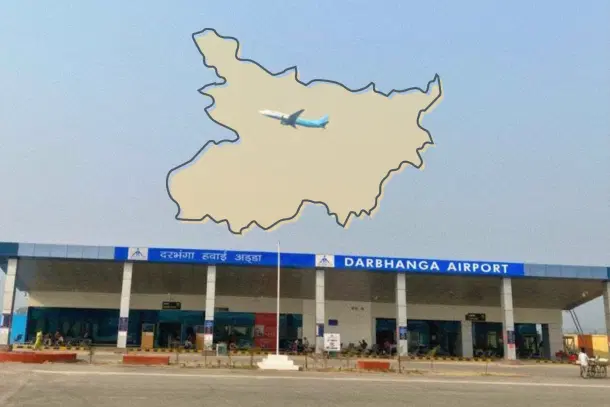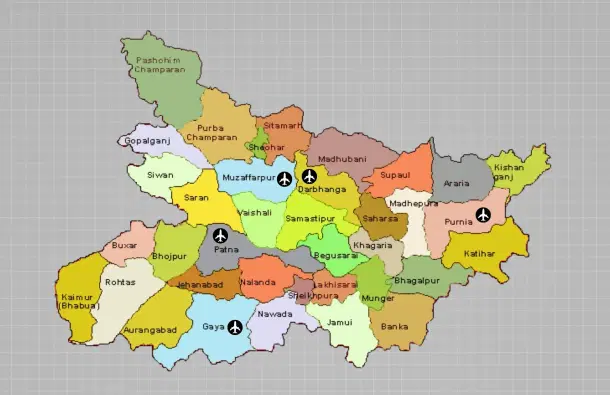Bihar
Bihar's Race For Airports: Why Are Two Adjoining Districts Getting An Airport Each?
Swarajya Staff
Nov 06, 2025, 01:14 PM | Updated 01:14 PM IST
Save & read from anywhere!
Bookmark stories for easy access on any device or the Swarajya app.


After the long-pending development of Patahi Airport received official approval, Muzaffarpur joined Bihar’s growing network of districts that have their own airports.
The Airports Authority of India (AAI) has issued a tender to establish a civil enclave at Muzaffarpur, a demand that remained pending for over four decades.
The bidding process focuses on infrastructure upgrades to support 19-seater aircraft, including runway enhancements, terminal facilities and logistics for commercial operations.
This approval comes at a politically significant time, coinciding with the Bihar Assembly elections. Moreover, this year has been particularly significant for the state’s aviation expansion.
A month ago, in September 2025, the Purnea Airport was inaugurated by Prime Minister Narendra Modi, and soon after, Muzaffarpur Airport received approval to move forward with its development.
With the approval of Muzaffarpur Airport, the state will have five operational airports.
Before 2019, Bihar had only two operational airports, one in Patna and the other in Gaya. Darbhanga Airport, the third airport for the state, became operational in 2019.
The development of airports is also seen as a driver of economic growth and regional progress, especially in a state like Bihar, which has continuously faced challenges of underdevelopment.
However, in the ongoing race to establish new airports across the state, it is important to note that the proposed Muzaffarpur Airport is located very close to Darbhanga district, at a distance of roughly 60 kilometres from the existing Darbhanga Airport and nearly 90 kilometres from Patna Airport.
Due to this geographical proximity, and the fact that the project has been a longstanding political and public demand, it has also become a subject of debate on whether it meets genuine infrastructural needs or serves only electoral interests.
The Longstanding Demand for Airports in Bihar
Airport development in Darbhanga, Muzaffarpur and even Purnea has long been a central demand, owing to their locations and existing airstrips.
Darbhanga Airport began operations in the early 1950s. Later it was taken over by the Indian Air Force in 1962 during the Indo-China War. Similarly, Purnea Airport was set up in 1963 to support military logistics after the war.
As per local chatter, in 1967, the Patahi Airstrip in Muzaffarpur was built to facilitate the visit of then Prime Minister Indira Gandhi. From 1967 to 1982, the airport was used for regular commercial flights to Patna.
Locals in Muzaffarpur, who have been actively campaigning for the development of Patahi Airport, say that in 2019, during Prime Minister Modi’s visit to Patahi, a promise was made to build the airport.
“The airport was added to the UDAN scheme to connect Muzaffarpur with other cities, but saw no progress,” as per local reports.
“There had been several rallies and online campaigns for the airport, but even then, Muzaffarpur lost its airport project, while Darbhanga Airport was developed, which started flights in 2019,” a local journalist adds.
Many in Muzaffarpur argue that Darbhanga’s airport progressed because unions in the Mithila region, as well as the local political leadership of that period, mobilised more effectively in its favour, while Muzaffarpur’s airport proposal failed to receive comparable backing and was eventually sidelined.
Aviation officials hold a contrarian view though. “Both airports already had runways, but Darbhanga Airport’s runway and infrastructure were suitable for starting operations. There was no need for additional land acquisition, the existing runway's length was suitable to handle larger flights. The airport was able to offer better connectivity with major cities,” said an official.
“In the case of Muzaffarpur, the runway is only about 1,050 metres, which can support only small aircraft. For any expansion, more land acquisition on both sides was needed from nearby villages, which would require relocating the villagers and going through a long land acquisition process,” he adds.
“Therefore, it was more practical and convenient even for the authorities to make Darbhanga Airport operational.”
Demand Intensified After Opening of Darbhanga Airport
Once Darbhanga Airport became operational, frustration among the people of Muzaffarpur grew stronger, as they had been demanding, and were even promised, an airport since 2019.
“Muzaffarpur is economically a little stronger than Darbhanga, so people here were upset that Darbhanga got an airport while Muzaffarpur still did not,” a local journalist from Muzaffarpur adds.
Since then, residents, civic groups and local industries have actively campaigned for its revival, using social media platforms with hashtags like #FlyFromMuzaffarpur. The discontent grew further when Purnea received final approval for its long-pending airport, which has now become operational.
“In 2024, a committee from the Airports Authority of India (AAI) inspected the site and recommended the acquisition of around 475 acres.”
“Now, just before the state elections, a tender has been issued for the project. As per current plans, the airport will begin with 19-seater aircraft, and if operations succeed, larger aircraft may be introduced later,” he added.
Thus, with growing local resentment and a sense of regional imbalance, Bihar is now set to have two airports in neighbouring districts, and three airports within a 100-kilometre reach.

The Success of Darbhanga Airport
So far, Darbhanga Airport has served as a major aviation hub for northern Bihar. Since its launch under the RCS-UDAN scheme, the facility has emerged as one of the most successful examples of regional air connectivity in India.
Its steady passenger growth is also driven by being the only airport serving nearly 13 to 15 districts across north Bihar, a region that previously had no air connectivity.
According to reports, in less than three years, the airport has handled over 1.4 million passengers and nearly 10,000 flights, with passenger numbers increasing from 1.5 lakh in FY 2020–21 to more than 6 lakh annually in subsequent years.
At present, Darbhanga Airport offers direct flights to major cities such as Delhi, Mumbai, Bengaluru, Hyderabad and Kolkata, with most routes operated by IndiGo and SpiceJet.
Many of these routes have now become commercially sustainable, with flights consistently operating at over 85 per cent load factors.
Currently, the airport handles around 1,500 passengers and 10 flights each day, occasionally recording higher passenger traffic than Patna Airport, which operates about 40 flights daily and serves 8,000 to 10,000 passengers.
For a simple comparison of traffic demand, Lucknow Airport in neighbouring Uttar Pradesh’s capital city manages around 120 to 130 flights per day, including both domestic and international services.
What Impact Will Muzaffarpur Airport Have
Of the dozen districts in the range of Darbhanga Airport, several eastern districts will now fall under the newly opened Purnea Airport’s range.
Residents of the Seemanchal districts, Araria, Kishanganj and Katihar, now have easier access to air travel without needing to travel to Darbhanga, Patna or Gaya.
Earlier, many passengers from this region also preferred Bagdogra Airport in West Bengal because it was closer than the airports in Bihar. The new Purnea Airport is also expected to support the Seemanchal region’s growing economy, as the area is a leading producer of makhana and corn.
However, the catchment area of the newly approved Patahi Airport in Muzaffarpur overlaps with that of Darbhanga and Patna airports. Patahi Airport will serve passengers from Muzaffarpur, Vaishali, Samastipur, Saran, Siwan, Sheohar, Sitamarhi, East Champaran and West Champaran, among others.
Of these, Vaishali and Saran are currently served by Patna Airport, while passengers from Sheohar and Sitamarhi prefer Darbhanga Airport, raising the question of whether the regional demand is strong enough to make multiple airports in such close proximity truly effective.
The addition of Muzaffarpur Airport may pose challenges not only in building its own passenger base but also in diverting traffic from Darbhanga Airport.
This could impact Darbhanga Airport’s performance, especially as Purnea Airport looks set to emerge as a commercially viable competitor.
Darbhanga Airport is already undergoing major upgrades, including the construction of a new terminal building, runway expansion and the installation of night landing and Instrument Landing Systems (ILS) to further enhance its capacity and passenger convenience.
As per locals, “Altogether, Muzaffarpur and Darbhanga airports will largely serve the same passenger base. There will be only a minor difference of 30 to 40 kilometres from most regions to reach either of the airports.”
Once operational, the new airport will provide convenience for the people of Muzaffarpur. However, its impact remains unlikely on larger passenger traffic patterns in regions already served by the existing Darbhanga or Patna airports.
Thus, under the present conditions, the future of this airport remains uncertain in terms of practical utility. Meanwhile, the government continues to pursue strategically located airports such as Raxaul and Bhagalpur for larger air connectivity. Raxaul Airport would serve western Bihar and nearby areas of Nepal, while Bhagalpur Airport would enhance connectivity for southeast Bihar.
With these developments, almost all regions of Bihar will have better access to airports and be more evenly represented on the state’s aviation map.




